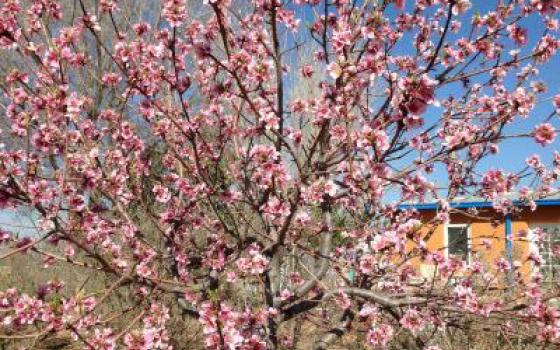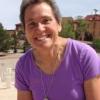On Thursday after Ash Wednesday I received the results of my post-chemotherapy PET scan. The doctor poked her head in the exam room door and said, "I have good news for you!" She gave me a big hug, handed the report to me to review and sat herself down at the computer screen. I quickly scanned down to the bottom of the page and saw the beautiful conclusion: "No lesions to suggest malignancy." The six courses of chemo did what I had hoped they would do. The healing process now is about the work of re-building and the season of Lent seems right on schedule.
Eight years ago as Lent began I received my first diagnosis of ovarian cancer and embarked on a six-month experience of surgery and chemotherapy. I remember coming home from the hospital in early March and seeing the big tractors clawing the dry fields in preparation for planting. "I feel like that!" I said. The forty days of Lent were a grinding experience that year.
This year my eyes are drawn to our raised bed gardens and the various greens that have survived the winter. Lent is springtime spinach, cilantro and kale. "I feel like that!" It is the early-blooming plum tree and the indoor geraniums that grace our windowsills. I am anxious to peek under the dry leaves that have been insulating our desert shrubs to see if this year’s shoots are creeping through. Lent is about new growth that comes from the reinvigoration of deep roots. Perhaps even my hair will grow again.
Something else very significant occurred as Lent began this year. Pope Francis came to Mexico, to Ciudad Juarez, and to the very edge of the Rio Grande that is the border. It was an experience of springtime. I followed every step of the pope's visit on television with a sense of wonder, fascination and hope. The fact is, for years almost no one has chosen to go to Mexico. Juarez was the "eight-murders-a-day" city until the drug war moved to other sectors. Forty-three student teachers disappeared in September of 2014 and nobody has been charged with the crime. The country has been stuck in a cold, dry winter — until Francis landed on February 12 and it seemed like the buds burst into bloom in the most unlikely places.
I shouldn't have been so surprised at this since Francis began his journey at the Basilica of Our Lady of Guadalupe. The images of his private prayer with Our Lady evoked her message of hope and reconciliation. Seated before the tilma of Juan Diego, the pope later said that he saw "etched in her eyes the eyes of all her children" and that she "gathers the pains of violence, kidnappings, killings and abuses that harm so many poor people, so many women" (Angelus message, Feb. 21, 2016). As I watched Francis embrace countless children, people with special needs, prisoners, the elderly, the sick, the poor, those routinely excluded and forgotten, it was like seeing a continuation of the mission of Juan Diego. Wherever he opened his arms there was a burst of color like those surprising flowers on Tepeyac.
I couldn't wait to see Pope Francis at the border! Being just three weeks out from my last chemo I knew that I did not have the stamina to attend the papal Mass nor even to accompany the "Francis VIPs" — the special group of immigrant women and children whom the pope requested to meet at the border before the Mass. That invitation was incredibly tempting but in the end I decided that I would be the designated driver for my community members who were able to participate in the celebrations on both sides of the border. And so I channel-surfed on television from the moment the pope’s plane touched down until the wheels went up 10 hours later.
The pope's encounter with his "VIPs" at the border was very brief, considering the incredible security preparations that were taken to provide the opportunity. The meeting was over in an instant and felt disappointing — but the pope's homily did not disappoint. He called to mind "the human tragedy that is forced migration" and challenged us, like Jonah the prophet, to repentance and response. As he spoke I felt that I was experiencing the power of a parable which Walter Brueggemann calls "the subversive voice of Scripture." Francis used the Gospel of the day, Jesus' recollection of the city of Nineveh, which responded to the prophetic call to repentance, to speak not just to the city of Juarez but to the world:
"This crisis, which can be measured in numbers and statistics, we want instead to measure with names, stories, families. They are the brothers and sisters of those excluded as a result of poverty and violence, drug trafficking and criminal organizations. Being faced with so many legal vacuums, they get caught up in a web that ensnares and always destroys the poorest. Not only do they suffer poverty but they must also endure these forms of violence."
The power of parable: The supreme pontiff had just walked up a ramp to the very edge of the Rio Grande. It was as far as the authorities permitted him to go. He stood there in silent prayer as he had done before Our Lady of Guadalupe. There was no microphone or bullhorn provided to carry his message to the immigrants some 50 yards away. He laid a bouquet of flowers on a little altar in memory of those who died attempting to cross the border. He raised his hands in blessing. Then he walked away to celebrate the Eucharist with almost a quarter of a million people at the Juarez fairgrounds. But his "VIPs" could only vaguely make out the altar and hear the hymns. They were sidelined looking to the south from whence they had come at such great cost, once again excluded from the banquet.
During the Mass an occasional camera provided a view of those blurred faces behind the 14-foot fence on the U.S. side of the border. As the pope sat in prayer while communion was being distributed I wondered if he, like Guadalupe, held their images in his eyes. "Let us together ask our God for the gift of conversion, the gift of tears, let us ask him to give us open hearts like the Ninevites, open to his call heard in the suffering faces of countless men and women," he had said moments earlier in his homily. "No more death! No more exploitation! There is still time to change, there is still a way out and a chance, time to implore the mercy of God."
I thought to myself, "He has done it again! With his actions-more-powerful-than-words Francis has shown us how to live the Gospel. Keep walking right up to the borders that divide and exclude. Open your arms so that the springtime of mercy can tumble out."
The experience of the visit of Pope Francis to Mexico has given added value to the emergence of spring at this point my healing process. The places that have suffered such violence and pain have received an infusion of vital energy and grace. There is such reason to hope!
[Janet Gildea, SC, has been a contributor to Global Sisters Report, writing on immigration and other topics from the U.S.-Mexico border. Janet began chemotherapy for recurrent ovarian cancer on October 6, 2015, an experience that she will be sharing in GSR over the next several months. Readers are also welcome to visit her blog, "Each Day Counts" at janetsc.wordpress.com. Access her Inter-Mission columns on GSR here.]




